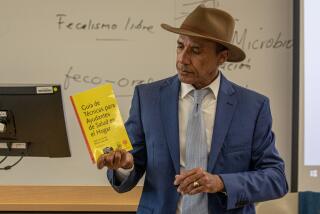Latin Revival: Ancient Roman Language Regains Popularity
- Share via
Below a set of posters of Roman gods hanging high on the walls of Irvine teacher Martha Altieri’s Latin class, a discreet sign sums up why most of her students study the ancient language: “Rise above the vulgar crowd, take Latin.”
A hubris-ridden sentiment? Perhaps.
An esoteric bunch of kids? Certainly.
An extinct language? Definitely not.
In fact, Latin is alive, kicking and growing in California elementary and high schools.
“Latin is immortal,” proclaimed Woodbridge High School senior Kerem Yilmaz, a student in Altieri’s advanced placement Latin IV class.
Yilmaz, like many California teenagers, said Latin is gaining popularity because it can help students improve their SAT scores, better understand the English language and make them stand out in the crowd.
Statewide, the rate of public school teenagers taking Latin has risen 30% since 1992. California ranked eighth in the nation last year--up from 13th in 1993--for the 4,600 private and public students who took the National Latin Exam, a voluntary test that awards high-scorers medals and scholarships.
Nationwide, interest in Latin is rising most rapidly at the elementary through middle schools, according to officials from the American Classical League, an association of Latin and Greek scholars. Their studies show that the number of elementary students learning Latin has doubled to 4,265 from 1990 to 1994 (the latest data available); at the middle schools, that figure rose 18% to 214,182.
Although the upward trend is encouraging to classicists, Latin still is studied by less than 1% of California students enrolled in foreign languages, the 1997 state data show.
At one time, Latin was a premier language to study, particularly among the college-bound. However, interest in Latin began to fizzle in the late 1960s because the language was seen as dead and irrelevant and less useful than a modern language. And just a few years earlier, the Catholic Church dropped Latin from Mass.
Since 1990, Latin has seen a steady resurgence in public schools. And the language generally has been thriving in Catholic and specialized programs such as the Boston Public Latin School, the first such program founded in 1635.
Complex, descriptive and exact, Latin is called “the language of endings.” That’s because every noun, adjective, verb and pronoun has a different ending for its various usages, Altieri said.
On a recent Monday, Altieri’s 10 students, considered a sizable class for this advanced course, picked apart eloquent lines from the “Aeneid,” Virgil’s epic poem about the hero Aeneas who left the burning ruins of Troy to found a new city in the West.
Laboring over every detail, senior Sam Kim tried to translate before his classmates a dramatic scene in which a pounding storm shatters Aeneas’ fleet.
“‘The wind--’ No, I mean ‘The east wind drives the (pause) . . . the wind from the deep sea (pause) . . . and to the shallow reef?” Kim said, his voice trailing off in confusion.
What Kim was starting to decode was this passage: “The east wind drives three ships from the deep sea on the flats and in the quicksands, miserable to be seen and dashes the ships on the shoals and surrounds them with the heap of sand.”
To understand Latin is to love language, have a command for parts of speech and be imaginative, Altieri said.
“It’s like a puzzle,” she explained. “You have to understand how words function in sentences in order to figure out the text.”
More to Read
Sign up for Essential California
The most important California stories and recommendations in your inbox every morning.
You may occasionally receive promotional content from the Los Angeles Times.













